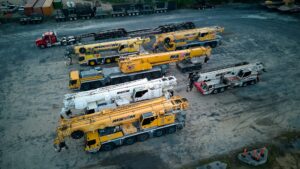
Buying an overhead crane from crane manufacturer is an expensive decision, so at least one is used to thinking about used cranes. It’s obviously a cheaper option on the surface, but is it really cheaper? Here are some questions to consider.
- Is the manufacturer still active? There have been numerous consolidations, closings, and bankruptcies in the crane industry. Will you be able to get parts for your crane? Many older cranes are more robust and have an integrated design that allows you to purchase many parts out of the box, as these are industry standard parts (NEMA, for example). This applies to motors, contactors, bearings, and couplings.
But many cranes and goods and passenger lift have components specifically designed for the crane manufacturer and do not use standard components. Component modifications may be necessary to ensure that later installed parts fit together properly. Many crane manufacturers require special motor shafts, contactors, manifold shoes, and electrification systems to list some that may or may not be available.
- What are my obligations if I buy a crane and make modifications to it? The responsibility of the manufacturer is entirely released after modifying your crane. If the crane is old, box girders may be riveted girders that are difficult to modify or a type of arched beam in a proprietary track design considered unsafe. Done correctly, the engineer must design and place his PE joint in any modification of the bridge girder.
- Does the crane have the right capacity for my application? Bigger is generally better in crane applications, but should you consider the cost of a good deal with more capacity than you need? There are additional costs to consider. The crane is heavier and you will need a larger track and supports to support only the dead load of the crane. Every spare part, like motors, brakes, contactors, and SWRs, is bigger and more expensive to replace. If you make any changes or updates to an electrical system, such as a VFD, those components will also be larger and more expensive.
- Does the elevator match my current power supply? There are many stories about a customer who bought an old crane and found it to be DC or bad voltage. You are then faced with expensive motor changes or reducing transformers or amplifiers. The power supply system has also been updated. Is electrification an old type of open-wire or an obsolete type of rod? Replacing electricity on an old crane is quite costly.
- Are you ready to waive the warranty? Used cranes and goods and passenger lift are generally not guaranteed. New cranes now typically ship with one-year parts and one-year extra parts for all unused items. You also get the latest parts instructions so you can order parts from the crane manufacturer.
- Who will make my modifications to the crane? If your crane requires a major new extension or major electrical modification, an experienced crane company should be involved. Where will it work? What are the additional shipping costs including picking up the crane, shipping to the store, and then returning to the scene? Will a professional engineer be behind all the work? If a crane has problems while in a store, who is responsible? The most commonly used cranes are “as is”.
There are many stories of well-used cranes being rehabilitated, but it takes some care and preparation to make the right decision.



